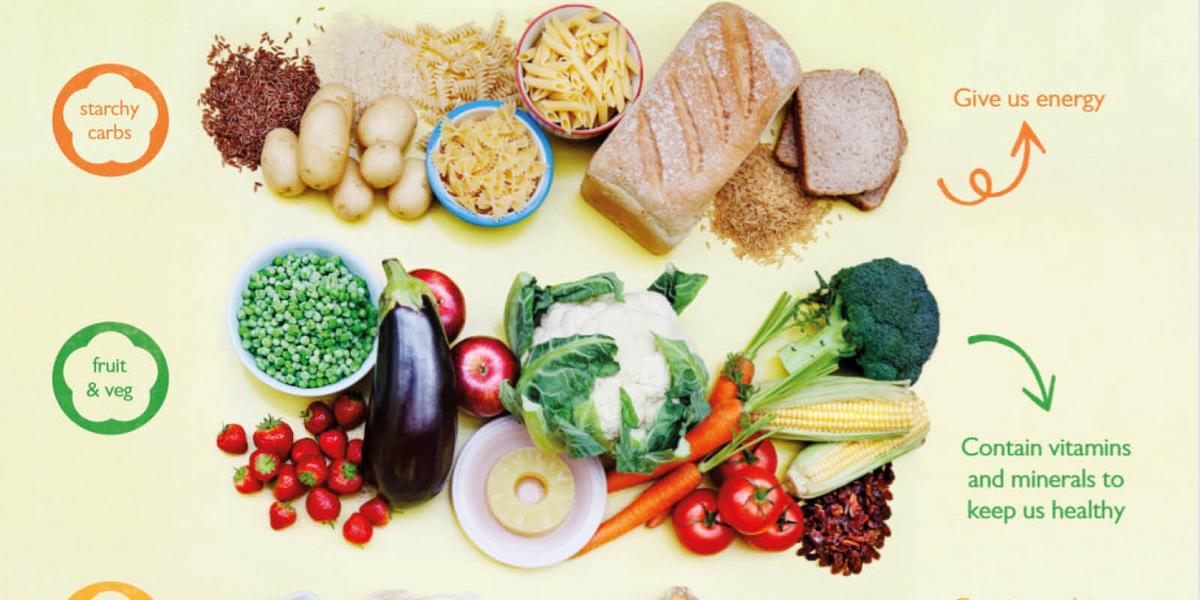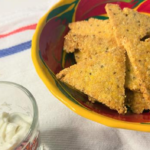We all want to enjoy good nutrition and we know that to achieve this goal we need information about the foods we consume on a daily basis. As a result of this need, the classification by food groups was created, so we can manage certain basic knowledge about our daily diet (what food gives us, how much we should consume from each group and how to combine the groups with each other). In this way, it is easier for us to design a balanced menu adjusted to our particular health, economic, geographic and taste needs.

Thinking about this, we bring you a very interesting and complete article, in which we explain what the basic food groups and their nutrients are so that you can get more out of your daily diet. A great article to teach children about nutrition!
The 7 food groups and their importance
Nutrition is the process by which our body separates, absorbs and uses the substances that make up food to use them for energy, plastic and/or regulatory purposes, that is, the body performs essential physiological functions to live thanks to these substances. Since the components that make up food are vital (carbohydrates, fats, proteins, vitamins, minerals and water), the need to know them very well is logical. For this reason, the idea of ordering food in groups arises, in order to have a practical and didactic guide, which serves to design a balanced diet for the entire population.
Graphically, this classification is represented in a wheel, which shows the seven food groups and some very relevant information about them, such as the similarity in nutritional aspect and composition. However, like this representation there are many others: System Nova from Brazil (which shows a conceptual innovation), Tromp Alimentation from Venezuela (a version of the pyramid), the Nutritional Pyramid or the Pyramid of Healthy Food, etc. Perhaps, the most popular among all, currently, is the Nutritional Pyramid, which is conceptually very similar to the wheel, but with some additional information and some variations. At this time, it is used more frequently worldwide; in fact it even serves as inspiration for other more recent versions. This pyramid divides and unites the different food groups to establish what would be a proper and healthy diet. It usually has five levels, in which you can see foods belonging to different groups.
It is interesting to mention that all these representations are so didactic that both adults and children can understand them. Here we show a simple pyramid with the food groups and the recommendations of the different official organizations, such as the WHO.
Food group 1: milk and dairy products
Foods classified as plastics, builders or repairers fall into this group. The main components of this category are proteins and fats or lipids (the higher the percentage of fat in the protein, the greater the energy power), followed by carbohydrates (lactose and GA lactose), vitamins (A and E), minerals and even some probiotics. The following foods are included in this group:
- Milk. It contains mostly water, a good dose of carbohydrates, as well as abundant vitamins and minerals (especially vitamin A, some B vitamins, calcium, phosphorus and magnesium), proteins of high biological value and fats.
- Yogurt. This dairy product is characterized by its probiotic properties: it protects the immune system and relieves digestive diseases. In addition, it mainly contains carbohydrates, proteins, fats, vitamin B12, calcium, phosphorus and zinc.
- Cheese. This product has a nutritional value very similar to that provided by milk; however, it contains more fat (mainly saturated) and therefore more calories. The more dehydrated the cheese (more compact and less water), the greater amount of nutrients it will provide.
- Butter. This dairy mainly provides fat (80% are saturated fats), 400 different fatty acids and vitamins A, D, E, B12 and K2. Due to its nutrients, the WHO recommends the consumption of butter but moderately, since this food also belongs to group 7, that is, to the group of fats.
- Ice cream its components are milk, sugar and cream (or butter). This food is mainly energetic due to its high fat and sugar content, although there are also light versions, such as the light fruit and yogurt ice cream that we show in this recipe.
Food group 2: meat, fish and eggs
In this category, foods whose function is plastic, construction or repair stand out, as in the previous food group. The products of this classification stand out for their high protein content (16-22%) of high biological value, fats, and abundant iron and B vitamins.
Meats
This includes red and white meats, from various types of livestock and poultry and classified as follows:
- High biological value: poultry, beef and pork (all have almost the same protein content, but have different amounts of fat).
- Less fat: beef, horse, chicken (without skin), turkey and rabbit.
- Rich in iron and B vitamins: certain organ meats, specifically liver, kidneys and heart.
Sausages
These products are prepared with meat, fat, seasonings and a modest amount of carbohydrates. It is interesting to mention that sausages contain meat and fat that come from various parts of the animal, the proportion of which varies according to the manufacturer’s recipe.
Eggs
This meat source is rich in essential amino acids and protein. In fact, it is considered the protein standard par excellence. Egg nutrients are distributed as follows:
- Clara: contains proteins (ovalbumin) and several of the nine essential amino acids.
- Yolk: provides fat (cholesterol) and micronutrients (vitamins A, B2, B12, D and E and minerals such as iron).
Fish and shellfish (crustaceans and mollusks)
The healthiest group 2 fats are found in fish and chicken eggs. In the case of fish, blue or fatty fish are richer in omega 3, in addition to other healthy fats. Seafood and its nutrients can be divided as follows:
- Fish: rich in phosphorus, sodium, iodine, potassium, iron, abundant omega 3 and a lot of protein, but in a lower proportion than in mollusks. In addition, the skeleton of the fish stands out for its large amount of calcium, while its skin, scales and bones provide abundant collagen.
- Mollusks and crustaceans: they stand out for their richness in zinc, copper and calcium. In addition, they contain a high percentage of protein and cholesterol (both in greater quantity than in fish).
Food Group 3: potatoes, legumes and nuts
Foods whose function is plastic and energetic are classified in this group. The most notable nutrients in this area are carbohydrates (quick energy), vitamins (especially vitamin E and B vitamins), minerals (mainly iron and calcium), and vegetable proteins with low biological content, fiber and healthy fats (fatty acids). Monounsaturated and polyunsaturated fats). Group 3 is made up of the following foods:
- Tubers. These foods stand out for their important contribution of carbohydrates, of which 18% is made up of starches, and significant potassium content. Some foods in this subgroup are sweet potatoes, cassava and potatoes.
- Legumes. Within this subcategory we find nutritional contributions such as vitamins, minerals, a high carbohydrate content, vegetable proteins of low biological value, although if they are combined with cereals they are transformed into vegetable proteins of high biological value, and fiber, mostly soluble. Some legumes are: beans, chickpeas, lentils, soybeans, carob beans and peanuts (generally considered a nut because of the way it is served, but it is really a legume), among others.
- Dried fruits. They mainly provide healthy fats such as omega 3 and minerals. In addition, in smaller quantities, they provide quality carbohydrates and proteins. Some nuts are: walnuts, hazelnuts, almonds, pistachios, sunflower seeds, chestnuts, among others.
Food group 4: greens and vegetables
Here food fulfills a regulatory function . These products are plants grown to be eaten raw or prepared, whose caloric content is very low in relation to their great contribution in essential nutrients. The main nutritional components of this food group are vitamins, minerals and fiber (mostly soluble). It also contains a large amount of water and a low percentage of fats, proteins and carbohydrates. This group is recommended to be consumed regularly and here are some foods of this classification:
- Spinach, watercress, Swiss chard, kale, lettuce, and parsley– contain plenty of iron.
- Red and green peppers and carrots: they provide vitamins A and C.
- Sweet Potatoes, Spinach, and Thistle– Provide potassium.
Food Group 5: Fruits
Regulatory foods are assigned to this food group. This category stands out for its high water and sugar content, mostly with a low caloric index. In addition, they share all the properties of group 4 (vegetables and vegetables).
The fruits are characterized by their fleshy consistency, which makes them suitable for consumption raw (some can be eaten with the skin and others cannot). This group is recommended to be consumed daily, with some foods in this category being the following:
- Orange, tomato, strawberry, grapefruit and kiwi: they provide abundant vitamin
- Peach, plum, melon and cherries: rich in vitamin A.
- Banana, avocado and watermelon: they contain potassium.
There are many more fruits that exist and all of them provide important nutrients. For this reason, including them in our daily diet is more than recommended. If you wonder if these foods can be eaten at night.
Food group 6: cereals, derivatives, sugars and sweets
In this classification, foods that fulfill an energetic function (as well as fats) are assigned. This set provides a high percentage of quick energy, which comes from its rich sources of carbohydrates, both simple (sugars) and complex. In addition, the whole grain products of this group provide a lot of fiber and micronutrients (mainly phosphorus, magnesium, and potassium and B vitamins). In this category we can mention the following products:
- Cereals: the composition of cereals varies depending on whether we are talking about refined or whole grains. Refined cereals contain sugars (such as cane sugar or honey) and fats (partially hydrogenated vegetable oil, that is, it provides a part of Tran’s fats). Also, during the refining process they lose nutrients, but manufacturers commonly compensate for this deficit by enriching them with vitamins and minerals. Whole grain breakfast cereals, on the other hand, retain their vitamins (group B and vitamin E) and minerals (iron, zinc, copper, magnesium, selenium and phosphorus). Cereals are commonly made with a single cereal or a combination of several (wheat, corn, rice, oats, rye or barley), in a refined or whole grain version.
- Bread: this food contains mainly carbohydrates and a large part of water. In smaller amounts, it provides proteins (including gluten), fats, B vitamins (B1, B2 and B6) and minerals (phosphorus, magnesium and potassium). However, bread made with refined flour loses many nutrients, unlike bread made with whole wheat flour. Finally, it is interesting to note that, although wheat bread is the most common, you can also find versions prepared with other cereals (corn, rice, among others), for which the nutritional contributions will vary depending on the type of cereal. See How to make homemade bread to make it at home.
- Pasta: Generally, it comes from durum wheat, which is processed to obtain semolina used to prepare this food. However, pasta is not only made with wheat, whose integral presentation is more nutritious. Currently, you can also find pasta made from corn, rice, rye and other varieties of cereals. The nutrients in pasta? They essentially depend on the type of cereal, but if it is wheat, they are basically the same compounds that exist in bread.
- Sweets: although they have a high energy value, their nutritional value is poor (low in vitamins and minerals). In addition, they contain many saturated fats, which are not particularly beneficial for the body. However, there are healthy versions made from whole meal flours, sweeteners, seeds, etc., which allow for more nutritious desserts. Some sweet foods are cakes, cupcakes, muffins, etc.
Food Group 7: Fats, Oils, and Butter
The last of the basic food groups. Foods that fulfill an energetic function are assigned to this group . This set mainly provides a high percentage of carbohydrates (quick energy) and some fat-soluble vitamins (vitamins A, D, E and K). The nutritional base of this category are fats or lipids, which fulfill several vital organic functions, since they are part of the structure of the membranes and are part of the main food of the brain along with carbohydrates, among other functions. There are two types of fats (according to their origin), animal and vegetable fats, which in turn are divided into:
- Saturated fats: butter, lard, beef, organ meats, or full-fat dairy. Excessive consumption of these fats raises LDL cholesterol, which is unfavorable for the cardiovascular system. It is recommended that the intake of saturated fat does not exceed 10% of total calories, thus ensuring a reduction in Tran’s fatty acids. Do not miss our selection of natural juices to lower cholesterol.
- Unsaturated fats, which are divided into monounsaturated and polyunsaturated: vegetable oils (olive, sesame, corn, soybean, peanut, sunflower, etc.), margarines (go through a hydrogenation process associated with Trans fats), nuts, fish fatty (salmon, sardines, etc.). These types of fats lower total cholesterol and LDL.
- Trans fat(AGT): they are unsaturated fatty acids that are formed from an industrial hydrogenation process, designed with the purpose of transforming liquid oil into solid fat. According to studies, fats can also be produced naturally in polygastric animals (cows, goats and sheep), inside the rumen (fermentation chamber that ruminants have). From there, the Trans fats are absorbed by the animal’s gastric system to pass into its muscles and milk (in small amounts). The WHO recommends consuming only 1% of Tran’s fats daily, since, like saturated fats, they can cause cardiovascular problems. The foods that contain this type of fat belong mostly to group 6, however, they are also contained in other groups, but very scarcely.
Water, caloric drinks and soft drinks
Although officially there are seven food groups (if we use the graphical representation of the wheel), informally this additional group is mentioned, made up of water, caloric beverages and soft drinks. Thus, this group includes water as a central element, since it is essential for humanity and life on the planet in general, and some other liquids. Water and some drinks from this possible group provide minerals and antioxidants, which are very important for the body. Other drinks, on the other hand, only contain a high percentage of sugars (carbohydrates). Some of the elements of this classification would be the following:
- Water: natural mineral, spring, prepared drinking water, etc.
- Caloric drinks, that is, without calories: tea, coffee and infusions.
- Refreshing drinks: soft drinks, refreshing juice drinks, flavored water, etc.



